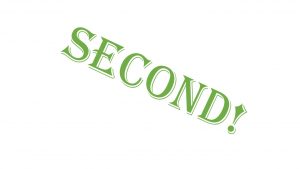Unraveling the mysteries of “second the motion”
Updated November 19, 2022
Second the motion—everybody knows how to do that, right? Well, in fact there are some funny ideas floating around about this ordinary act of meeting procedure.
Let’s unravel the mysteries.
Second the motion—why?
Robert’s Rules of Order Newly Revised, 12th edition, says that a person seconds a motion in order to indicate that they would like to talk about it. In other words, “second the motion” is an affirmation of interest in the proposal. The theory is that there ought to be at least two people who are interested in an idea before the group spends its time in discussing it.
In the olden days, to second the motion meant that you approved of it—that you sponsored it. This is no longer so. You can even second a motion you disagree with, if you would like to explain why it’s a bad idea.
Robert says that if the members have started discussing a motion, no formal second is needed, since it is already clear that at least two people wish to discuss it.
Second the motion—how?
If you wish to second a motion, once the maker has stated the motion, just call out “second!” You do not need to be recognized (acknowledged) by the chair. The chair, hearing your second, should then immediately say, “It has been moved and seconded that…. Is there any discussion?” The person who makes the motion has the right to speak first in favor of it, if they wish to.
Second the motion—when?
For large groups, a second is required before a motion can be taken up by the assembly (group). However, Robert’s Rules of Order has special rules for small boards. If you are in a small board (up to about 12 people) or a committee, no second is required, according to Robert. Read about the small board rules here.
Note that Jurassic Parliament has a different position. We believe that it is ALWAYS good to require a second, even in small boards. Otherwise, you run the risk of “grandstanding”—people making a motion just to hear their own voice, or to make a political point. This is not a good use of the group’s time.
There is another circumstance where a second is not required. If a committee of the body has recommended a certain course of action, and the chair moves the motion to carry it out at the end of the report, no second is necessary. This is because the committee consists of more than one member, so by recommending the action, more than one member has endorsed it.
Second the motion—silence?
If a member makes a motion and no one seconds it, the chair may ask, “Is there a second?” and pause briefly. If no one speaks up, the chair should say, “Hearing no second, the motion will not be considered” and move briskly on to the next item of business. A trainee once told me how the chair had asked her to second a motion. Don’t do this! All these acts should be purely voluntary.
Committee recommendations don’t need a second
If a committee made up of members of the body presents a recommendation to the body, no second is needed, since at least two members support the recommendation. This does not apply when, for example, a committee of the association presents a recommendation to the board. The board processes the recommendation in the usual way.
Name of seconder—in the minutes?
Robert’s Rules says that the name of the seconder should not be included in the minutes. However, if you are a body subject to a law, regulation or policy that requires this, go with that authority! In the State of Washington, for instance, we have heard that the Small Cities Auditor will mark down cities who produce municipal minutes that do not include the name of the seconder.
No second to the motion—in the minutes?
The Robert’s Rules Association has issued an opinion that all main motions should be included in the minutes, even those which have not been seconded. You can read it here – it is opinion 2006-7, and is still valid. Since the opinion is not part of the book of Robert’s Rules, it is not binding, but the Association considers that it should be strongly persuasive.
Jurassic Parliament disagrees with this position. We prefer that main motions that have not been taken up for lack of a second should NOT be included in the minutes. If you agree and you want to be correct, you can pass a special rule of order that says that motions that are not seconded should not be included in the minutes. Read how to pass a special rule of order here.
Second the motion—can you withdraw a second?
While it is possible to withdraw a motion (read how here), from our perspective it is NOT possible to withdraw a second. The second just “starts the ball rolling,” so to speak, so you can’t take it back after the discussion is chugging along.
Some motions don’t need a second
Note that there are several motions in Robert’s Rules that don’t need a second: nominations, Point of Order, Request for Information, and so on. You can read details in Robert’s Rules of Order Newly Revised, 12th edition, tinted pages 6-33.
Does this untangle the mysteries of “second the motion”? Is it all clear as mud? Share your questions with us!



Ann, I love your website content. I’m just getting into the depth of parliamentary procedures and really appreciate how plain and clear your writing is.
Could you explain a little bit why your preference is not to record main motions that aren’t seconded? Is it because it is more efficient for the secretary not to make minutes about business that didn’t happen? My understanding is that minutes are a record of what was done by the assembly, which does *not* equate to a verbatim/transcript. So if a main motion hasn’t even gotten to be an item of discussion, it hasn’t become “business” yet.
Suppose the main motion is seconded but no debate ensues, does the Chair then call the question and proceed with the vote?
Jay, we feel that if someone makes a main motion and no one seconds it, that is not worthy of the secretary’s time or the assembly’s attention in the official record. The motion is not viable, it’s just a thought of an individual person. In at least one instance we’re familiar with, a member of a body often made motions that had no chance of being considered, as a way of politicking or making personal statements.
And yes, if a motion is made and seconded, and there is no debate, after a decent pause, the chair would take the vote. Note that we prefer not to say that the chair would “call the question,” since that phrase commonly refers to the “Call for the Question” or “Previous Question,” which is a specific motion to end debate and vote immediately. See our blog post here.
So glad that you find our site helpful! We strive to distill out the practical aspects that people need. Thanks for your kind words, and good luck with your parliamentary studies.
Ann